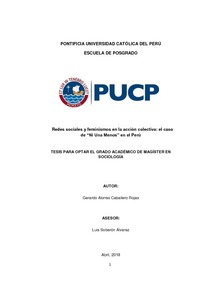| dc.contributor.advisor | Soberón Álvarez, Luis | |
| dc.contributor.author | Caballero Rojas, Gerardo Alonso | |
| dc.date.accessioned | 2018-04-21T01:55:32Z | es_ES |
| dc.date.available | 2018-04-21T01:55:32Z | es_ES |
| dc.date.created | 2018 | es_ES |
| dc.date.issued | 2018-04-21 | es_ES |
| dc.identifier.uri | http://hdl.handle.net/20.500.12404/11944 | |
| dc.description.abstract | La presente investigación indaga sobre los factores que permitieron el surgimiento de una multitudinaria movilización de rechazo a la violencia contra la mujer, sucedida en Lima el 13 de agosto del 2016 y que fue conocida con el nombre de “Ni Una Menos”. Al mismo tiempo, el estudio explora las posibles repercusiones que tuvo este evento en el movimiento feminista y en la sociedad en su conjunto. Para ello hemos recurrido a los conceptos de acción colectiva, movimientos sociales y activismo, así como a los de redes sociales y capital social. El trabajo encuentra que contribuyeron al éxito de la movilización la existencia previa de una red de activistas del movimiento feminista y la incorporación de un grupo de mujeres ajenas a estos círculos y que tenían distintas redes y capital social. También influyó un proceso de activación
socioemocional ocurrido en el espacio virtual gracias a una plataforma de Facebook, así como la adopción de estrategias destinadas a ampliar el potencial de movilización del feminismo. Esto permitió que la marcha recibiera una alta cobertura mediática y la
atención de autoridades del gobierno, lo que permitió visibilizar la violencia de género. Sin embargo, el proceso de organización de la marcha reprodujo las
antiguas tensiones que existían entre las vertientes del movimiento de mujeres. | es_ES |
| dc.description.abstract | The present research investigates the factors that allowed the emergence of a
massive mobilization of rejection of violence against women, which took place in Lima on August 13, 2016 and was known as "Ni Una Menos". At the same time, the study explores the possible repercussions that this event had on the feminist movement and on society as a whole. For this we have resorted to the concepts of collective action, social movements and activism, as well as those of social networks and social capital.
This work finds that the previous existence of a network of activists of the feminist movement and the incorporation of a group of women outside these circles who had different networks and social capital contributed to the success of the mobilization. It also influenced a process of socio-emotional activation that occurred in the virtual space thanks to a Facebook platform, as well as the adoption of strategies aimed at expanding the mobilization potential of feminism. This allowed the march to receive high media coverage and the attention of government authorities, which made gender violence visible. However, the process of organization of the march reproduced the old tensions that existed between the slopes of the women's movement. | es_ES |
| dc.description.uri | Tesis | es_ES |
| dc.language.iso | spa | es_ES |
| dc.publisher | Pontificia Universidad Católica del Perú | es_ES |
| dc.rights | info:eu-repo/semantics/openAccess | es_ES |
| dc.rights.uri | http://creativecommons.org/licenses/by-nc-nd/2.5/pe/ | * |
| dc.subject | Mujeres -- Violencia contra -- Perú | es_ES |
| dc.subject | Feminismo -- Perú | es_ES |
| dc.subject | Movimientos sociales -- Perú | es_ES |
| dc.subject | Redes sociales -- Perú | es_ES |
| dc.title | Redes sociales y feminismos en la acción colectiva: el caso de “Ni Una Menos” en el Perú | es_ES |
| dc.type | info:eu-repo/semantics/masterThesis | es_ES |
| thesis.degree.name | Magíster en Sociología | es_ES |
| thesis.degree.level | Maestría | es_ES |
| thesis.degree.grantor | Pontificia Universidad Católica del Perú. Escuela de Posgrado | es_ES |
| thesis.degree.discipline | Ciencias Sociales con mención en Sociología | es_ES |
| renati.discipline | 314567 | es_ES |
| renati.level | https://purl.org/pe-repo/renati/level#maestro | es_ES |
| renati.type | http://purl.org/pe-repo/renati/type#tesis | es_ES |
| dc.publisher.country | PE | es_ES |
| dc.subject.ocde | https://purl.org/pe-repo/ocde/ford#5.04.01 | es_ES |






